Page 1470 of 3419
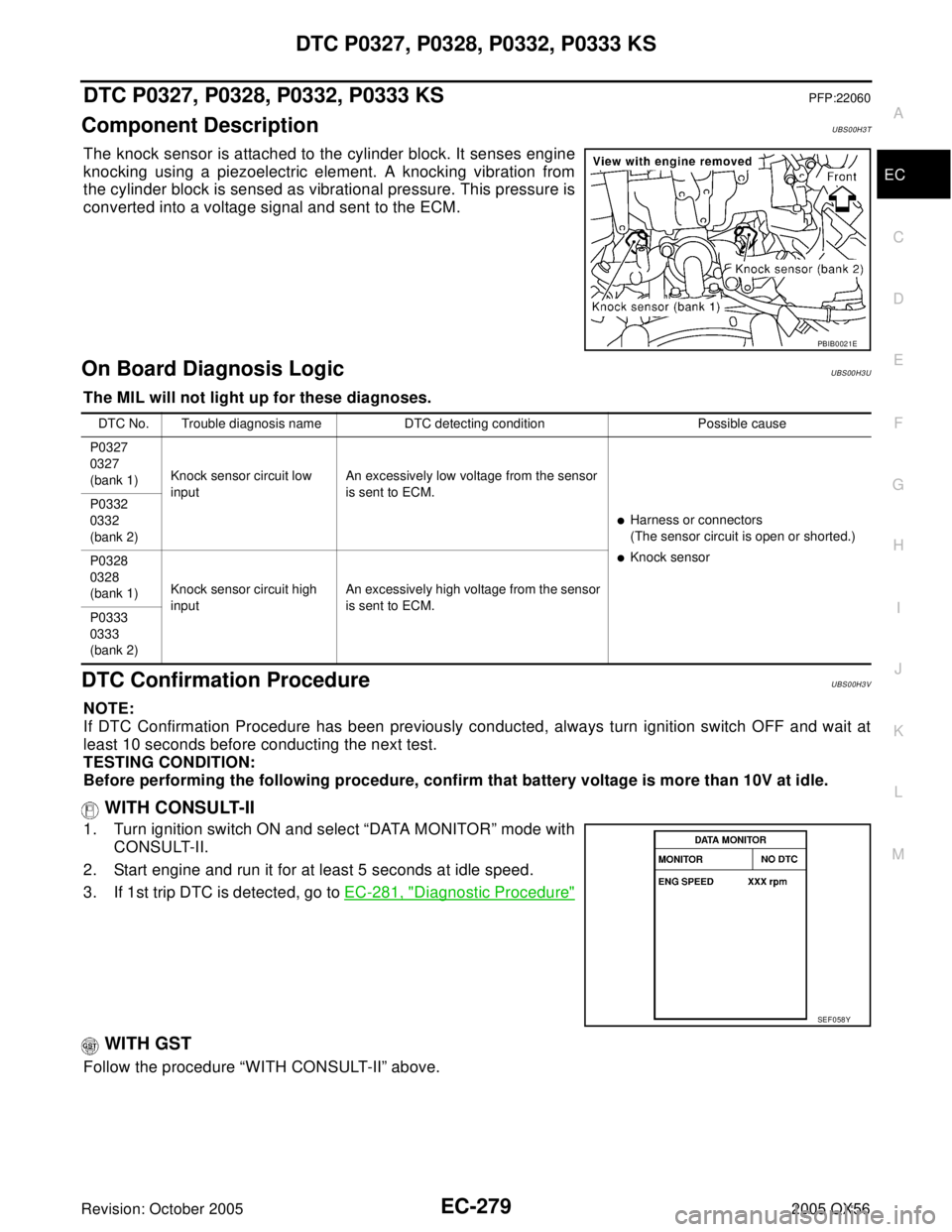
DTC P0327, P0328, P0332, P0333 KS
EC-279
C
D
E
F
G
H
I
J
K
L
MA
EC
Revision: October 20052005 QX56
DTC P0327, P0328, P0332, P0333 KSPFP:22060
Component DescriptionUBS00H3T
The knock sensor is attached to the cylinder block. It senses engine
knocking using a piezoelectric element. A knocking vibration from
the cylinder block is sensed as vibrational pressure. This pressure is
converted into a voltage signal and sent to the ECM.
On Board Diagnosis LogicUBS00H3U
The MIL will not light up for these diagnoses.
DTC Confirmation ProcedureUBS00H3V
NOTE:
If DTC Confirmation Procedure has been previously conducted, always turn ignition switch OFF and wait at
least 10 seconds before conducting the next test.
TESTING CONDITION:
Before performing the following procedure, confirm that battery voltage is more than 10V at idle.
WITH CONSULT-II
1. Turn ignition switch ON and select “DATA MONITOR” mode with
CONSULT-II.
2. Start engine and run it for at least 5 seconds at idle speed.
3. If 1st trip DTC is detected, go to EC-281, "
Diagnostic Procedure"
WITH GST
Follow the procedure “WITH CONSULT-II” above.
PBIB0021E
DTC No. Trouble diagnosis name DTC detecting condition Possible cause
P0327
0327
(bank 1)Knock sensor circuit low
inputAn excessively low voltage from the sensor
is sent to ECM.
�Harness or connectors
(The sensor circuit is open or shorted.)
�Knock sensor P0332
0332
(bank 2)
P0328
0328
(bank 1)Knock sensor circuit high
inputAn excessively high voltage from the sensor
is sent to ECM.
P0333
0333
(bank 2)
SEF 0 58 Y
Page 1474 of 3419
DTC P0327, P0328, P0332, P0333 KS
EC-283
C
D
E
F
G
H
I
J
K
L
MA
EC
Revision: October 20052005 QX56
Component InspectionUBS00H3Y
KNOCK SENSOR
Check resistance between knock sensor terminal 1 and ground.
NOTE:
It is necessary to use an ohmmeter which can measure more
than 10 MΩ.
CAUTION:
Do not use any knock sensors that have been dropped or phys-
ically damaged. Use only new ones.
Removal and InstallationUBS00H3Z
KNOCK SENSOR
Refer to EM-73, "CYLINDER BLOCK" . Resistance: Approximately 532 - 588 kΩ [at 20°C (68°F)]
SEF 2 27 W
Page 1495 of 3419
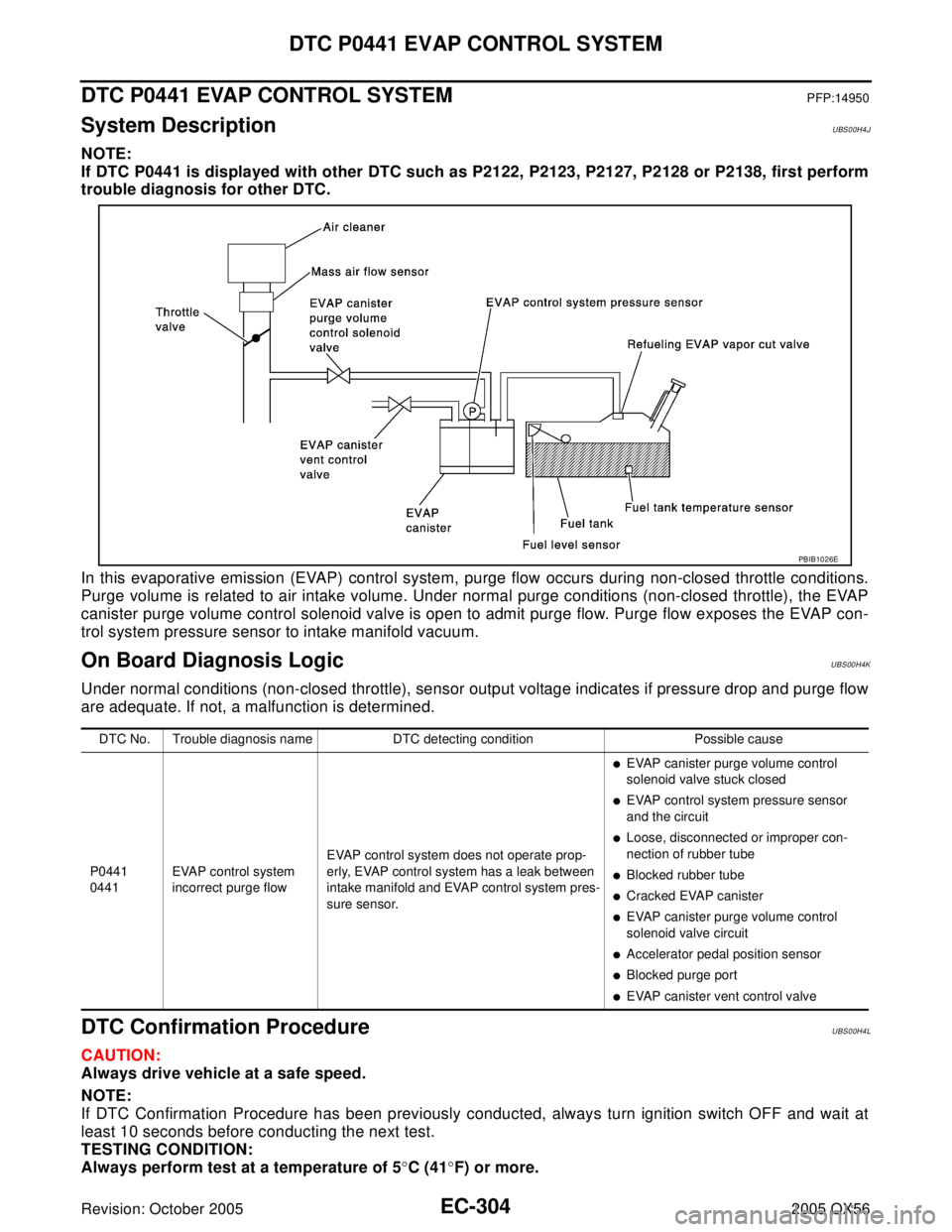
EC-304Revision: October 2005
DTC P0441 EVAP CONTROL SYSTEM
2005 QX56
DTC P0441 EVAP CONTROL SYSTEMPFP:14950
System DescriptionUBS00H4J
NOTE:
If DTC P0441 is displayed with other DTC such as P2122, P2123, P2127, P2128 or P2138, first perform
trouble diagnosis for other DTC.
In this evaporative emission (EVAP) control system, purge flow occurs during non-closed throttle conditions.
Purge volume is related to air intake volume. Under normal purge conditions (non-closed throttle), the EVAP
canister purge volume control solenoid valve is open to admit purge flow. Purge flow exposes the EVAP con-
trol system pressure sensor to intake manifold vacuum.
On Board Diagnosis LogicUBS00H4K
Under normal conditions (non-closed throttle), sensor output voltage indicates if pressure drop and purge flow
are adequate. If not, a malfunction is determined.
DTC Confirmation ProcedureUBS00H4L
CAUTION:
Always drive vehicle at a safe speed.
NOTE:
If DTC Confirmation Procedure has been previously conducted, always turn ignition switch OFF and wait at
least 10 seconds before conducting the next test.
TESTING CONDITION:
Always perform test at a temperature of 5°C (41°F) or more.
PBIB1026E
DTC No. Trouble diagnosis name DTC detecting condition Possible cause
P0441
0441EVAP control system
incorrect purge flowEVAP control system does not operate prop-
erly, EVAP control system has a leak between
intake manifold and EVAP control system pres-
sure sensor.
�EVAP canister purge volume control
solenoid valve stuck closed
�EVAP control system pressure sensor
and the circuit
�Loose, disconnected or improper con-
nection of rubber tube
�Blocked rubber tube
�Cracked EVAP canister
�EVAP canister purge volume control
solenoid valve circuit
�Accelerator pedal position sensor
�Blocked purge port
�EVAP canister vent control valve
Page 1502 of 3419
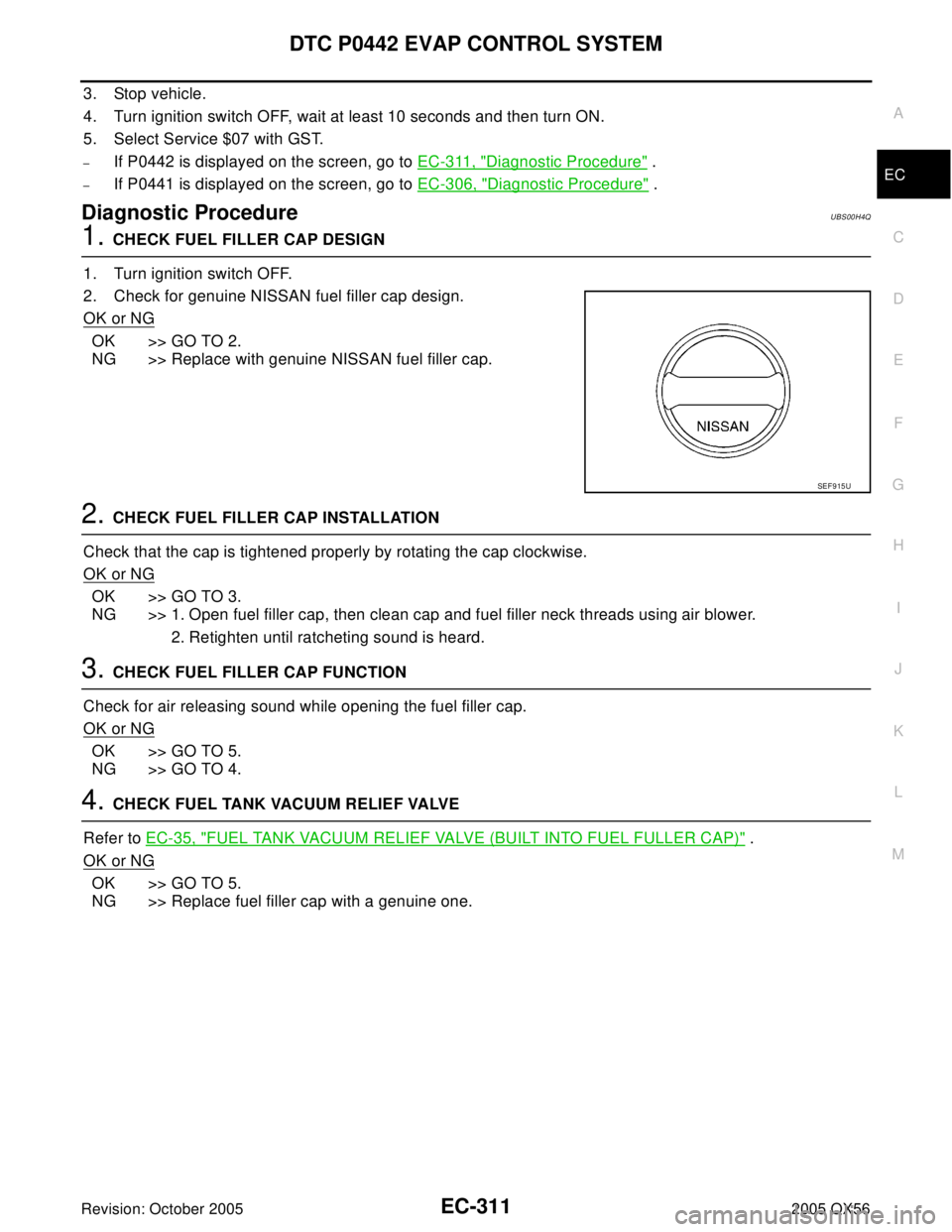
DTC P0442 EVAP CONTROL SYSTEM
EC-311
C
D
E
F
G
H
I
J
K
L
MA
EC
Revision: October 20052005 QX56
3. Stop vehicle.
4. Turn ignition switch OFF, wait at least 10 seconds and then turn ON.
5. Select Service $07 with GST.
–If P0442 is displayed on the screen, go to EC-311, "Diagnostic Procedure" .
–If P0441 is displayed on the screen, go to EC-306, "Diagnostic Procedure" .
Diagnostic ProcedureUBS00H4Q
1. CHECK FUEL FILLER CAP DESIGN
1. Turn ignition switch OFF.
2. Check for genuine NISSAN fuel filler cap design.
OK or NG
OK >> GO TO 2.
NG >> Replace with genuine NISSAN fuel filler cap.
2. CHECK FUEL FILLER CAP INSTALLATION
Check that the cap is tightened properly by rotating the cap clockwise.
OK or NG
OK >> GO TO 3.
NG >> 1. Open fuel filler cap, then clean cap and fuel filler neck threads using air blower.
2. Retighten until ratcheting sound is heard.
3. CHECK FUEL FILLER CAP FUNCTION
Check for air releasing sound while opening the fuel filler cap.
OK or NG
OK >> GO TO 5.
NG >> GO TO 4.
4. CHECK FUEL TANK VACUUM RELIEF VALVE
Refer to EC-35, "
FUEL TANK VACUUM RELIEF VALVE (BUILT INTO FUEL FULLER CAP)" .
OK or NG
OK >> GO TO 5.
NG >> Replace fuel filler cap with a genuine one.
SEF 9 15 U
Page 1542 of 3419
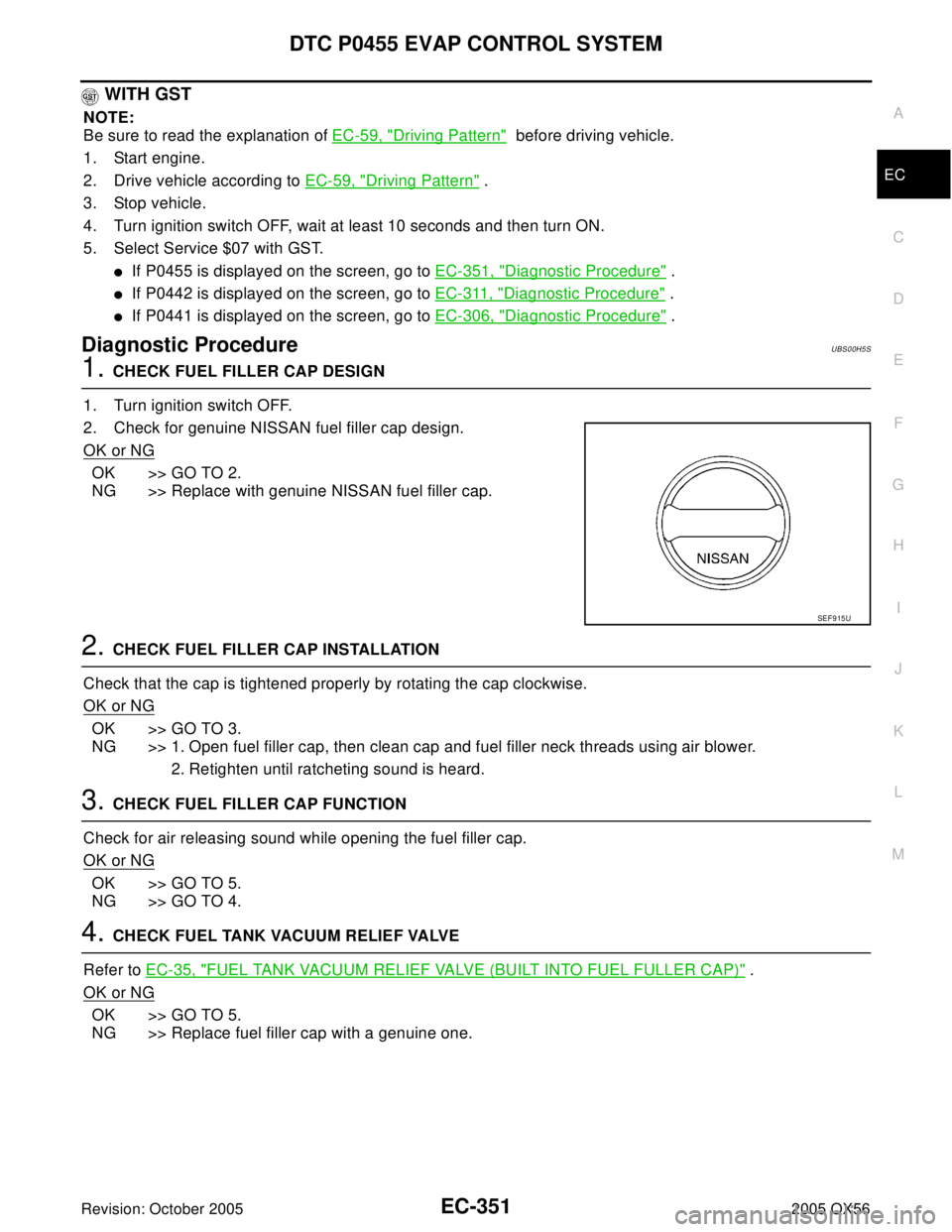
DTC P0455 EVAP CONTROL SYSTEM
EC-351
C
D
E
F
G
H
I
J
K
L
MA
EC
Revision: October 20052005 QX56
WITH GST
NOTE:
Be sure to read the explanation of EC-59, "
Driving Pattern" before driving vehicle.
1. Start engine.
2. Drive vehicle according to EC-59, "
Driving Pattern" .
3. Stop vehicle.
4. Turn ignition switch OFF, wait at least 10 seconds and then turn ON.
5. Select Service $07 with GST.
�If P0455 is displayed on the screen, go to EC-351, "Diagnostic Procedure" .
�If P0442 is displayed on the screen, go to EC-311, "Diagnostic Procedure" .
�If P0441 is displayed on the screen, go to EC-306, "Diagnostic Procedure" .
Diagnostic ProcedureUBS00H5S
1. CHECK FUEL FILLER CAP DESIGN
1. Turn ignition switch OFF.
2. Check for genuine NISSAN fuel filler cap design.
OK or NG
OK >> GO TO 2.
NG >> Replace with genuine NISSAN fuel filler cap.
2. CHECK FUEL FILLER CAP INSTALLATION
Check that the cap is tightened properly by rotating the cap clockwise.
OK or NG
OK >> GO TO 3.
NG >> 1. Open fuel filler cap, then clean cap and fuel filler neck threads using air blower.
2. Retighten until ratcheting sound is heard.
3. CHECK FUEL FILLER CAP FUNCTION
Check for air releasing sound while opening the fuel filler cap.
OK or NG
OK >> GO TO 5.
NG >> GO TO 4.
4. CHECK FUEL TANK VACUUM RELIEF VALVE
Refer to EC-35, "
FUEL TANK VACUUM RELIEF VALVE (BUILT INTO FUEL FULLER CAP)" .
OK or NG
OK >> GO TO 5.
NG >> Replace fuel filler cap with a genuine one.
SEF 9 15 U
Page 1551 of 3419
EC-360Revision: October 2005
DTC P0456 EVAP CONTROL SYSTEM
2005 QX56
Diagnostic ProcedureUBS00H5W
1. CHECK FUEL FILLER CAP DESIGN
1. Turn ignition switch OFF.
2. Check for genuine NISSAN fuel filler cap design.
OK or NG
OK >> GO TO 2.
NG >> Replace with genuine NISSAN fuel filler cap.
2. CHECK FUEL FILLER CAP INSTALLATION
Check that the cap is tightened properly by rotating the cap clockwise.
OK or NG
OK >> GO TO 3.
NG >> 1. Open fuel filler cap, then clean cap and fuel filler neck threads using air blower.
2. Retighten until ratcheting sound is heard.
3. CHECK FUEL FILLER CAP FUNCTION
Check for air releasing sound while opening the fuel filler cap.
OK or NG
OK >> GO TO 5.
NG >> GO TO 4.
4. CHECK FUEL TANK VACUUM RELIEF VALVE
Refer to EC-35, "
FUEL TANK VACUUM RELIEF VALVE (BUILT INTO FUEL FULLER CAP)" .
OK or NG
OK >> GO TO 5.
NG >> Replace fuel filler cap with a genuine one.
SEF 9 15 U
Page 1639 of 3419
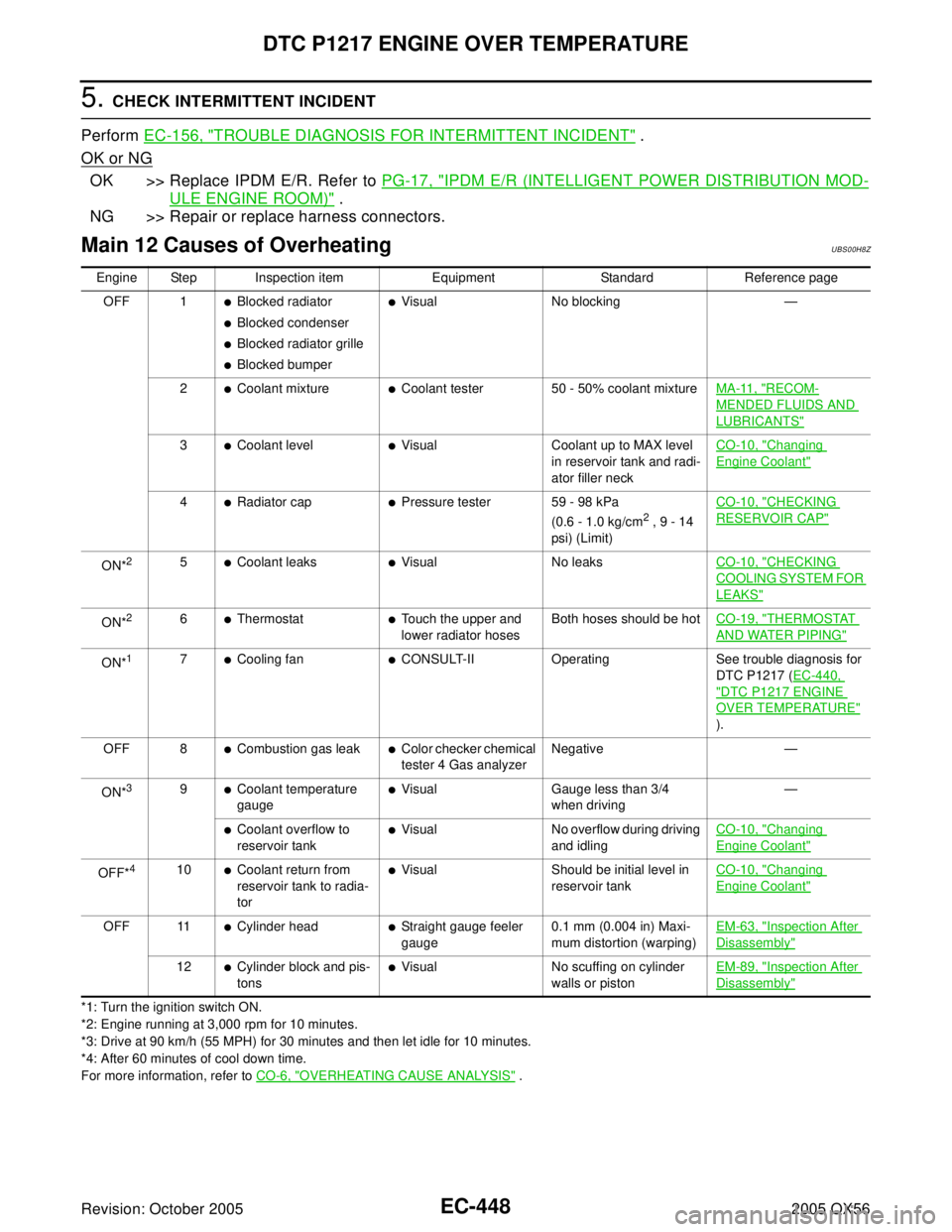
EC-448Revision: October 2005
DTC P1217 ENGINE OVER TEMPERATURE
2005 QX56
5. CHECK INTERMITTENT INCIDENT
Perform EC-156, "
TROUBLE DIAGNOSIS FOR INTERMITTENT INCIDENT" .
OK or NG
OK >> Replace IPDM E/R. Refer to PG-17, "IPDM E/R (INTELLIGENT POWER DISTRIBUTION MOD-
ULE ENGINE ROOM)" .
NG >> Repair or replace harness connectors.
Main 12 Causes of OverheatingUBS00H8Z
*1: Turn the ignition switch ON.
*2: Engine running at 3,000 rpm for 10 minutes.
*3: Drive at 90 km/h (55 MPH) for 30 minutes and then let idle for 10 minutes.
*4: After 60 minutes of cool down time.
For more information, refer to CO-6, "
OVERHEATING CAUSE ANALYSIS" . Engine Step Inspection item Equipment Standard Reference page
OFF 1
�Blocked radiator
�Blocked condenser
�Blocked radiator grille
�Blocked bumper
�Visual No blocking —
2
�Coolant mixture�Coolant tester 50 - 50% coolant mixtureMA-11, "RECOM-
MENDED FLUIDS AND
LUBRICANTS"
3�Coolant level�Visual Coolant up to MAX level
in reservoir tank and radi-
ator filler neckCO-10, "Changing
Engine Coolant"
4�Radiator cap�Pressure tester 59 - 98 kPa
(0.6 - 1.0 kg/cm2 , 9 - 14
psi) (Limit)CO-10, "
CHECKING
RESERVOIR CAP"
ON*25�Coolant leaks�Visual No leaksCO-10, "CHECKING
COOLING SYSTEM FOR
LEAKS"
ON*26�Thermostat�Touch the upper and
lower radiator hosesBoth hoses should be hotCO-19, "THERMOSTAT
AND WATER PIPING"
ON*17�Cooling fan�CONSULT-II Operating See trouble diagnosis for
DTC P1217 (EC-440,
"DTC P1217 ENGINE
OVER TEMPERATURE"
).
OFF 8
�Combustion gas leak�Color checker chemical
tester 4 Gas analyzerNegative —
ON*
39�Coolant temperature
gauge�Visual Gauge less than 3/4
when driving—
�Coolant overflow to
reservoir tank�Visual No overflow during driving
and idlingCO-10, "Changing
Engine Coolant"
OFF*410�Coolant return from
reservoir tank to radia-
tor�Visual Should be initial level in
reservoir tankCO-10, "Changing
Engine Coolant"
OFF 11�Cylinder head�Straight gauge feeler
gauge0.1 mm (0.004 in) Maxi-
mum distortion (warping)EM-63, "Inspection After
Disassembly"
12�Cylinder block and pis-
tons�Visual No scuffing on cylinder
walls or pistonEM-89, "Inspection After
Disassembly"
Page 1730 of 3419
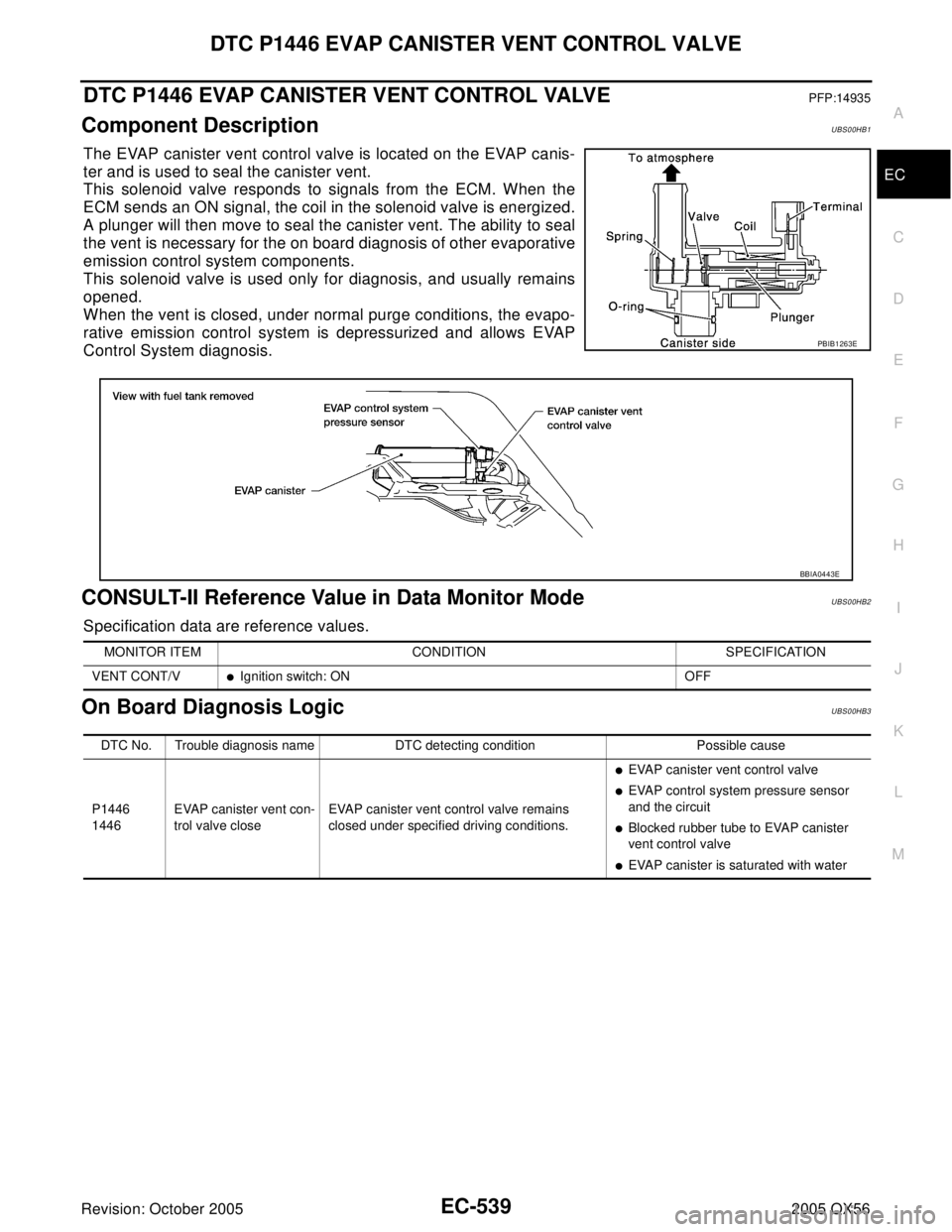
DTC P1446 EVAP CANISTER VENT CONTROL VALVE
EC-539
C
D
E
F
G
H
I
J
K
L
MA
EC
Revision: October 20052005 QX56
DTC P1446 EVAP CANISTER VENT CONTROL VALVEPFP:14935
Component DescriptionUBS00HB1
The EVAP canister vent control valve is located on the EVAP canis-
ter and is used to seal the canister vent.
This solenoid valve responds to signals from the ECM. When the
ECM sends an ON signal, the coil in the solenoid valve is energized.
A plunger will then move to seal the canister vent. The ability to seal
the vent is necessary for the on board diagnosis of other evaporative
emission control system components.
This solenoid valve is used only for diagnosis, and usually remains
opened.
When the vent is closed, under normal purge conditions, the evapo-
rative emission control system is depressurized and allows EVAP
Control System diagnosis.
CONSULT-II Reference Value in Data Monitor ModeUBS00HB2
Specification data are reference values.
On Board Diagnosis LogicUBS00HB3
PBIB1263E
BBIA0443E
MONITOR ITEM CONDITION SPECIFICATION
VENT CONT/V
�Ignition switch: ON OFF
DTC No. Trouble diagnosis name DTC detecting condition Possible cause
P1446
1446EVAP canister vent con-
trol valve closeEVAP canister vent control valve remains
closed under specified driving conditions.
�EVAP canister vent control valve
�EVAP control system pressure sensor
and the circuit
�Blocked rubber tube to EVAP canister
vent control valve
�EVAP canister is saturated with water